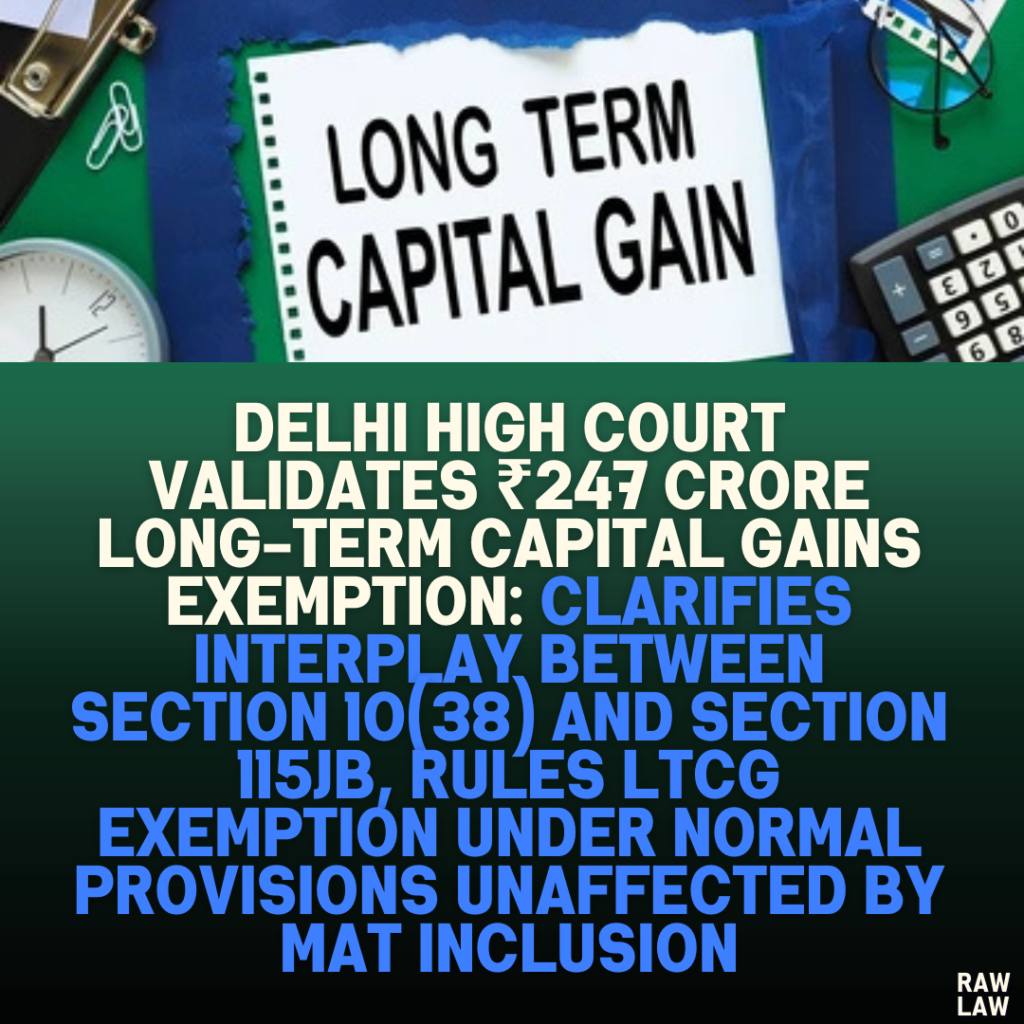Court’s Decision
The Delhi High Court rejected the Revenue’s contention that the exemption under Section 10(38) of the Act was improperly allowed. It held that the Assessee was entitled to claim LTCG exemption under the normal provisions of Section 10(38), notwithstanding the treatment of the same under Section 115JB for MAT computation. The court concluded that the decisions of the CIT(A) and the ITAT were legally sound and required no interference.
Facts of the Case
- Background:
- The Assessee, a company incorporated under the Companies Act, 1956, filed its income tax returns for AY 2015-16, declaring losses.
- Following a court-approved Scheme of Arrangement under Sections 391 to 394 of the Companies Act, five companies were amalgamated with the Assessee with effect from 01.08.2014.
- LTCG Exemption:
- The amalgamating companies sold shares of Indiabulls Housing Finance Limited, resulting in LTCG of ₹280.62 crores.
- Of this, ₹33.09 crores was reflected as profit, and ₹247.52 crores was credited to the capital reserve, with the Assessee claiming the LTCG as exempt under Section 10(38).
- Assessing Officer’s (AO) Findings:
- The AO denied the exemption for ₹247.52 crores, adding it to the book profits under Section 115JB (MAT provisions) and to the total income under normal provisions.
- Appeals:
- The CIT(A) allowed the Assessee’s claim for exemption under Section 10(38) but upheld the inclusion of LTCG in the MAT computation.
- The ITAT dismissed the Revenue’s appeal, affirming the CIT(A)’s decision.
Issues for Determination
- LTCG Exemption:
- Can LTCG claimed as exempt under Section 10(38) be denied if it is not reflected in the book profits for MAT under Section 115JB?
- Interplay Between Section 10(38) and Section 115JB:
- Does the proviso to Section 10(38), which mandates inclusion of LTCG in book profits for MAT computation, affect the eligibility for exemption under normal provisions?
Petitioner’s Arguments (Revenue)
- The Revenue contended that:
- LTCG not included in the book profits under Section 115JB disentitles the Assessee from claiming exemption under Section 10(38).
- The Assessee’s approach violates the proviso to Section 10(38), which requires LTCG to be accounted for in MAT calculations.
Respondent’s Arguments (Assessee)
- The Assessee argued:
- The exemption under Section 10(38) was claimed as per law, satisfying all stipulated conditions.
- The proviso to Section 10(38) pertains exclusively to MAT computation and does not restrict the exemption under normal provisions.
- The Revenue’s interpretation conflates distinct provisions and misconstrues legislative intent.
Analysis of the Law
- Section 10(38):
- Exempts LTCG from taxable income if certain conditions are met, such as the transaction being chargeable to Securities Transaction Tax (STT).
- Proviso to Section 10(38):
- The proviso mandates inclusion of LTCG in book profits for MAT computation under Section 115JB.
- This provision aims to ensure consistency in MAT computation for companies claiming LTCG exemptions.
- Interplay Between Provisions:
- The exemption under Section 10(38) operates under normal tax provisions, while the MAT under Section 115JB is a separate framework for computing minimum tax liability.
- The court emphasized that the proviso does not negate the exemption but only regulates MAT computation.
Precedent Analysis
- The court referred to the legislative history and explanatory notes of the Finance Act, 2006, which introduced the proviso to Section 10(38).
- It noted that the amendment was designed to align MAT computation with the inclusion of exempt LTCG but did not restrict the exemption under normal provisions.
Court’s Reasoning
- Misinterpretation by Revenue:
- The court observed that the Revenue conflated the MAT framework under Section 115JB with the normal tax provisions.
- The inclusion of LTCG in book profits for MAT computation does not preclude the exemption claim under normal provisions.
- Legislative Intent:
- The court analyzed the language of Section 10(38) and its proviso, concluding that the intent was to regulate MAT computation without altering the nature of the exemption.
- CIT(A) and ITAT Decisions:
- Both authorities correctly interpreted the law, maintaining the Assessee’s eligibility for exemption under Section 10(38) while ensuring compliance with MAT provisions.
Conclusion
The Delhi High Court upheld the decisions of the CIT(A) and ITAT, affirming that the Assessee was entitled to claim LTCG exemption under Section 10(38). The court dismissed the Revenue’s appeal, ruling that no substantial question of law arose.
Implications
- Taxpayer Relief:
- The judgment provides clarity on the distinct operation of MAT provisions and normal tax exemptions, preventing undue denial of legitimate claims.
- Consistency in Interpretation:
- The ruling underscores the importance of adhering to legislative intent and avoiding conflated interpretations of tax provisions.
- Precedential Value:
- The decision may guide similar disputes, reinforcing the Assessee’s rights under Section 10(38) while ensuring compliance with MAT requirements.



